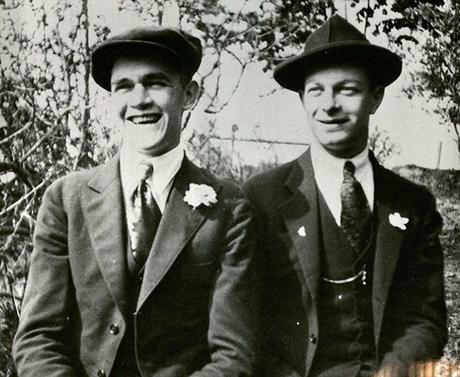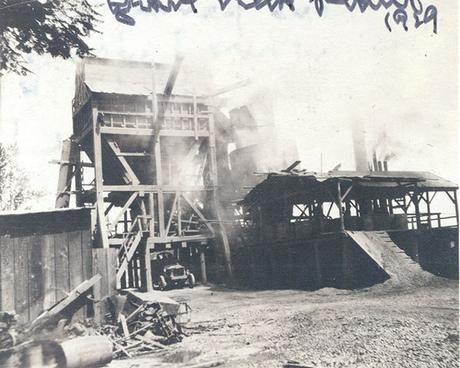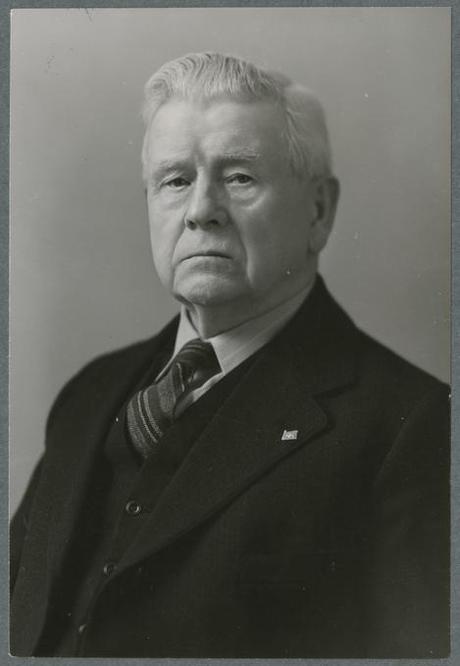 Paul Emmett and Linus Pauling, circa 1919
Paul Emmett and Linus Pauling, circa 1919[Ed Note: Next week, school begins anew here at Oregon State University. And as has become tradition at around this time, we reflect back today on Linus Pauling’s attendance at Oregon Agricultural College one-hundred years ago. In this three-part series, we explore Pauling’s life and the culture of OAC during the 1919-1920 academic year.]
Linus Pauling began the summer of 1919 in a job he detested. Working 60 hours a week, Pauling held a position at Riverside Dairy that was responsible for “monitoring the quality of the bitumen-stone mixes” used in the company’s products. Exhausted and bored, Pauling started his search for a new summer job within only a couple of weeks.
Quickly he found a more desirable job with the Oregon State Highway Department working as a plant inspector at the Wolf Creek-Grave Creek section of the Pacific Highway. Importantly, the position allowed Pauling to work closely with chemicals, and once the new opportunity was confirmed, Pauling left the Riverside Dairy in favor of Josephine County, Oregon, where he would help to oversee the paving process.

As the end of summer neared, Pauling began to prepare himself to return to Oregon Agricultural College for his junior year as a Chemical Engineering student. However, he soon received devastating news: his mother, who as in dire financial straits, had used all of his savings to keep the family afloat in Portland, meaning that there was no money available to fund his continued schooling.
Defeated, Pauling continued his work as a plant inspector and, once September rolled around, he found himself debating paving techniques with other inspectors rather than attending classes in Corvallis. But even in these debates, Pauling relied upon his scientific training to put forth an informed argument and to contradict the conventional wisdom. Specifically, Pauling claimed that the state’s guidance to lay pavement at temperatures between 225-275 degrees Fahrenheit was not accurate enough; 275 degrees was, in Pauling’s view, necessary for the best outcome.

Fortunately for Pauling, Oregon Agricultural College had seen an unprecedented growth in enrollment that fall and was now confronting a crisis as faculty struggled to meet the needs of a much larger student body. In late October, OAC Dean of Chemistry John Fulton reached out to Pauling – who was by then well-known to the faculty as being an exceptional talent – and offered him a position teaching analytical chemistry. Pauling was 18 years old at the time of the offer.
Though it would come with a $25 pay decrease to $100 per month, Pauling readily accepted the job, returning to campus on November 14 and officially beginning work as an instructor in Chemistry on November 20, 1919. Pauling’s personnel file indicates that this was not his first job within the Chemistry department – the previous academic year he had been employed as a student assistant, charged with mixing solutions for use in general chemistry laboratories.
Despite the pay decrease, Pauling found that his new job did come with a few perks. Nestled in Science Hall (present day Furman Hall) Pauling worked primarily on the second floor, which was dedicated to quantitative analysis, and was assigned his own office. He also enjoyed the services of his own assistant, a Mr. Douglas, who helped prepare solutions for the courses that Pauling instructed (the same job that Pauling had held the year before).
In winter 1920, his debut as a collegiate instructor, Pauling taught three courses: two sections of quantitative analysis for mining engineers, chemical engineers and pharmacy students; and one section of general chemistry for agriculture, home economics, and entry-level engineering students. The courses were listed as Chemistry 244 and Chemistry 102 respectively. In these three classes combined, Pauling taught 83 students, one of whom was his close friend Paul Emmett, later to become an influential catalysis chemist. Emmett received an A in Pauling’s quantitative analysis course for chemical engineering and pharmacy students.
And as the year progressed, Dean Fulton and Pauling developed a consequential academic relationship and also a friendship. Importantly, it is likely that Fulton referred Pauling to a series of papers authored by Irving Langmuir and G.N. Lewis that became very influential in his later research. Following Pauling’s graduation from OAC, Fulton also supplied $100 and $200 loans to support Pauling’s research during his graduate school years at the California Institute of Technology.
With one term of instruction under his belt, Pauling’s horizons began to expand and his interest in the opportunities offered by an OAC education started to wither. In particular Pauling believed that the land grant curriculum put forth by OAC was lacking, particularly in its attention to theory, and increasingly he found himself drawn to Caltech and its new Gates Chemical Laboratory. As he considered a transfer, Pauling initiated a brief correspondence with Caltech’s Chemistry head A.A. Noyes, and he also secured a letter of recommendation from John Fulton. In the end though, Pauling was simply unable financially to commit to a move to southern California, and decided to stay on at OAC for another term as an instructor.
For spring term, Pauling was assigned two new courses: Chemistry 242 and Chemistry 245. Both were quantitative analysis surveys designed for engineering students and each included at least one lecture, one recitation, and anywhere from three to twelve hours of lab work per week. Each day of Pauling’s schedule had several morning hours blocked out for preparing and delivering the majority of his lectures.

Pauling’s research notebook for that year – annotated with a hand-written “Keep Out! No Admittance” across the front cover – is riddled with student grades, calculations and notes on experimental methods. Pauling was compelled to consult this journal when, after finishing his position at the end of spring term and returning to his pavement inspector job, Dean Fulton contacted him at his Wolf Creek address. In his letter, Fulton requested that Pauling decipher some of the notes on quizzes that he had administered to his students during the previous term. Fulton also needed clarification on unknown solutions that he had produced and used during his classes.
Pauling’s appointment for the academic year ended in June 1920 and by June 11th, when OAC’s students were wrapping up their final examinations, “the boy professor” was returning to his position with the Oregon State Highway Department. He did so having also applied for a job as an assayer at Mountain Copper Company in Keswick, California, but he ultimately decided not to make the move so far south. During the summer months that followed, Pauling worked especially hard to accrue enough savings to support a true junior year at Oregon Agricultural College. Fortunately, he was able to do so and returned to campus the following fall, eager to begin classes after a one year hiatus.
